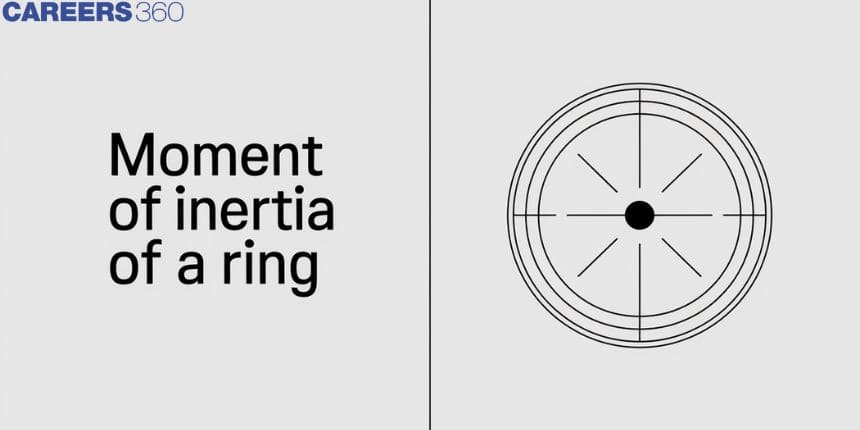Moment Of Inertia Of A Ring
The moment of inertia of a rigid body about a given axis of rotation is the sum of the products of the masses of the various particles and squares of their perpendicular distance from the axis of rotation. Two theorems, namely the perpendicular axis theorem and the parallel axis theorem, can be used to calculate the mass moment of inertia of a circular ring from the axis of rotation placed in the ring's plane, similar to a diameter passing from the centre, after determining the mass moment of inertia of the circular ring when the axis of rotation is passing from the centre.

In this article, we will cover the concept of the moment of inertia of a ring. This topic falls under the broader category of rotational motion, which is a crucial chapter in Class 11 physics. It is not only essential for board exams but also for competitive exams like the Joint Entrance Examination (JEE Main), National Eligibility Entrance Test (NEET), and other entrance exams such as SRMJEE, BITSAT, WBJEE, BCECE and more. Over the last ten years of the JEE Main exam (from 2013 to 2023), three questions have been asked on this concept. And for NEET one question was asked from this concept.
Let's read this entire article to gain an in-depth understanding of the moment of inertia of a ring
Moment of Inertia of a Ring
Let I= Moment of inertia of a RING about an axis through its centre and perpendicular to its plane.
To find out I Consider a ring of mass m, radius R and centre O.

Take an elementary portion of the ring of mass dm and length dx.
Next, we calculate
Substituting the values, we get;
Using integration;
Moment of Inertia of a Ring About an Axis Passing Through Its Diameter

From the formula, which we study earlier;
Now, We need to find dm. We will get;
Meanwhile,
The next step is to carry out the integration. We will have;
Following this derivation, we'll go on to several solved examples to help you understand the concept.
Solved Examples Based on the Moment of Inertia of a Ring
Example 1: The moment of inertia of a circular wire of mass M and radius R about its diameter is
1)
2)
3)
4)
Solution:
Moment of inertia for Ring -
wherein
About an axis perpendicular to the ring \& passing through the centre.
The moment of inertia of a circular wire about a diameter is
Hence, the answer is the option (1).
Example 2: Moment of inertia of a semi-circular ring about an axis which is perpendicular to the plane of the ring and passes through the centre :
1)
2)
3)
4)
Solution:
Moment of inertia for Ring
Let
Consider a whole ring of mass
For half ring
Therefore the half portion of the Ring will be a semicircular ring of Radius (R) and mass (M)
Example 3: What will be the moment of inertia of a ring whose mass is not uniformly distributed? Given that the density of the material is
1)
2)
3)
4)
Solution:
The moment of inertia in both the cases i.e., when mass is uniformly distributed or non-uniformly distributed is the same.
Hence, the answer is the option 2.
Example 4: Two rings have their moment of inertia in the ratio of 2:1 and their diameter are in the ratio 1:2. The ratio of the masses of the rings will be:
1) 4:1
2) 2:1
3) 1:4
4) 8:1
Solution:
Hence, the answer is the option (4).
Example 5: The moment of inertia of a uniform thin rod about a perpendicular axis passing through one end is
1) 8
2) 16
3) 24
4) 56
Solution:


Hence the answer is (8).
Summary
The moment of inertia for a rigid body is a physical quantity that combines mass and shape in Newton's equations of motion, momentum, and kinetic energy. The moment of inertia is applied in both linear and angular moments, although it manifests itself in planar and spatial movement in rather different ways. One scalar quantity defines the moment of inertia in planar motion.
Frequently Asked Questions (FAQs):
Q 1: What is the formula for the moment of inertia of a ring?
Ans: The formula for the moment of inertia of a rod when the axis is through the centre is
Q 2: What is a circular ring?
Ans: A circular ring is an equal mass distribution system of particles where the particles are placed at an equal distance from the centre.
Q 3: Is there any difference between the moment of inertia and rotational inertia?
Ans: No
Q 4: Is the moment of inertia a scalar or a vector quantity?
Ans: Scalar quantity
Q 5: Does the moment of inertia change with the change of the axis of rotation?
Ans: Yes
Also Read
26 Sep'24 11:01 AM
26 Sep'24 10:50 AM
26 Sep'24 10:42 AM
25 Sep'24 06:38 PM
25 Sep'24 06:32 PM
25 Sep'24 05:41 PM
25 Sep'24 05:40 PM
25 Sep'24 03:41 PM
25 Sep'24 03:41 PM
25 Sep'24 03:39 PM

